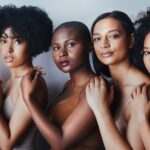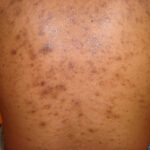We’re all going to age and it will definitely have a visible impact on our skin; considering wrinkles and mainly hyperpigmentation. But don’t we want to age gracefully? I know I do! So how do we achieve this while keeping our skin safe and healthy? It all comes down to the holy grail *sun protection factor*- we’ll come back to this later, let’s talk about science.
Biochemical Triggers
It is important to understand the science behind it. Wrinkles, hyperpigmentation and loss of skin tone- these are changes with aging skin. Age-related skin conditions are the result of genetically programmed changes, known as intrinsic factors and extrinsic factors. Let’s break this down below:
- Intrinsic factors: mainly controlled by genetics that occurs naturally. It is affected by the degenerative effects of free radicals, hormonal shifts and the inability to repair skin damage perfectly.
- The three chemical reactions that influence skin aging:
- Reactive Oxygen Species (ROS): these are free radicals which are tiny molecules that are highly reactive. Exposure to environmental stress can increase ROS levels dramatically, causing significant damage to cellular structures- this is oxidative stress.
- Matrix Metalloproteinases (MMP): these are naturally occurring enzymes (elastase and collagenase) that break down proteins in the extracellular matrix of the dermis. Within hours of environmental exposure, MMPs are activated, which degrade and inhibit the formation of healthy proteins. Long term- this ultimately leads to fine lines and wrinkles.
- Advanced Glycation End-Products (AGEs): collagen and elastin proteins are highly susceptible to a chemical reaction in the body called ‘glycation’ which can lead to AGES. The same glucose that provides energy for our cells can react with collagen, forming AGES and ROSs. Cellular processes are signalled to make collagen brittle and lead to inflammation- which rapidly accelerates skin ageing.
- While both influence the skin’s structure and function, extrinsic factors accelerate the aging process. This includes:
- Extrinsic factors: the environment, our lifestyle habits and UV exposure.
- Atmospheric factors such as ozone pollution: the most toxic environmental stressors. Although it cannot penetrate, it has the ability to induce oxidative stress-reducing skin-saving antioxidants and damaged skin cells.
- IR Radiation: exposure to IR radiation causes significant degrade in antioxidants in the skin and a reduction in collagen synthesis- increasing inflammation and pigmentation.
- Overconsumption of alcohol can add years to your face. Increasing wrinkles and broken capillaries.
- Smoking: Nicotine causes blood vessels to narrow, reducing oxygen flow and nutrients to skin cells- increasing wrinkles and decreasing collagen formation.
- Exposure to UVA and UVB rays dramatically increase skin aging- especially hyperpigmentation for rich complexions.
Can you relate to any skin changes from any of these factors? Let us know below!
Reverse the signs
It’s better to start early…but it’s never too late. No matter what age, dark marks or pigmentation you may have, there are always methods to treat, maintain and protect the issue. These include;
- The wonderful Vitamin C- great for treating and reversing pigmentation, dark marks and discolouration.
- Antioxidants- protect the skin from free radicals, oxidative stress and provides brightening effects.
- Vitamin A/Retinol- increases collagen and elastin production. Thickens skin and reduces wrinkles and pigmentation.
- Peptides- increases elastin and collagen. Increase firmness and reduces cripply skin and deep wrinkles.
- SPF- the ultimate product to help other ingredients to work better and protect and prevent the skin from UV damage and discolouration.
What are your tricks to maintain your youthful rich complexion? Share your tips below!
Sun Protection Factor
Did you know UV-induced sun damage accounts for over 80% of the structural changes that occur from skin aging? Research has shown the majority of skin’s visible changes (such as discolouration) to environmental factors is UV exposure. Hyperpigmentation is the main struggle we face when it comes to aging- so we must protect our rich complexions. When our skin is unprotected, we are allowing our skin to be exposed to the damaging effects of UVA and UVB radiation. At this point tyrosinase and pigment in our skin are stimulated, increasing the appearance of discolouration, dark marks and dark scars. Without SPF, hyperpigmentation will never get better.
No protection? No improvement. You will not get the results you want if you don’t protect your skin against harmful radiation. For instance; If you use a vitamin C serum to treat discolouration (which is highly recommended) without an SPF, there is no benefit at all, as you’re feeding your skin brightening ingredients to your skin, at the same time it is exposed to harmful radiation all day every day. In fact, it is much recommended to use vitamin c in conjunction with an SPF as it helps the vitamin to work better and efficiently. We must use sun protection daily to improve, treat and protect our rich complexions. (SPF is our best friend!)
How has sunscreen benefited your skin? Share your experience below!
Rich Complexions Age Gracefully!
All in all, as human beings, we can age gracefully with the use of sun protection in our daily routine. Encourage healthy skin every day and embracing our rich complexion! We are all surrounded by aging factors all day every day. To help reduce pigmentation issues, dark marks and scars, discolouration. Hopefully, we have understood and can take away the knowledge and importance of skin protection from ageing, and physically use an SPF.
What are your views on this?



